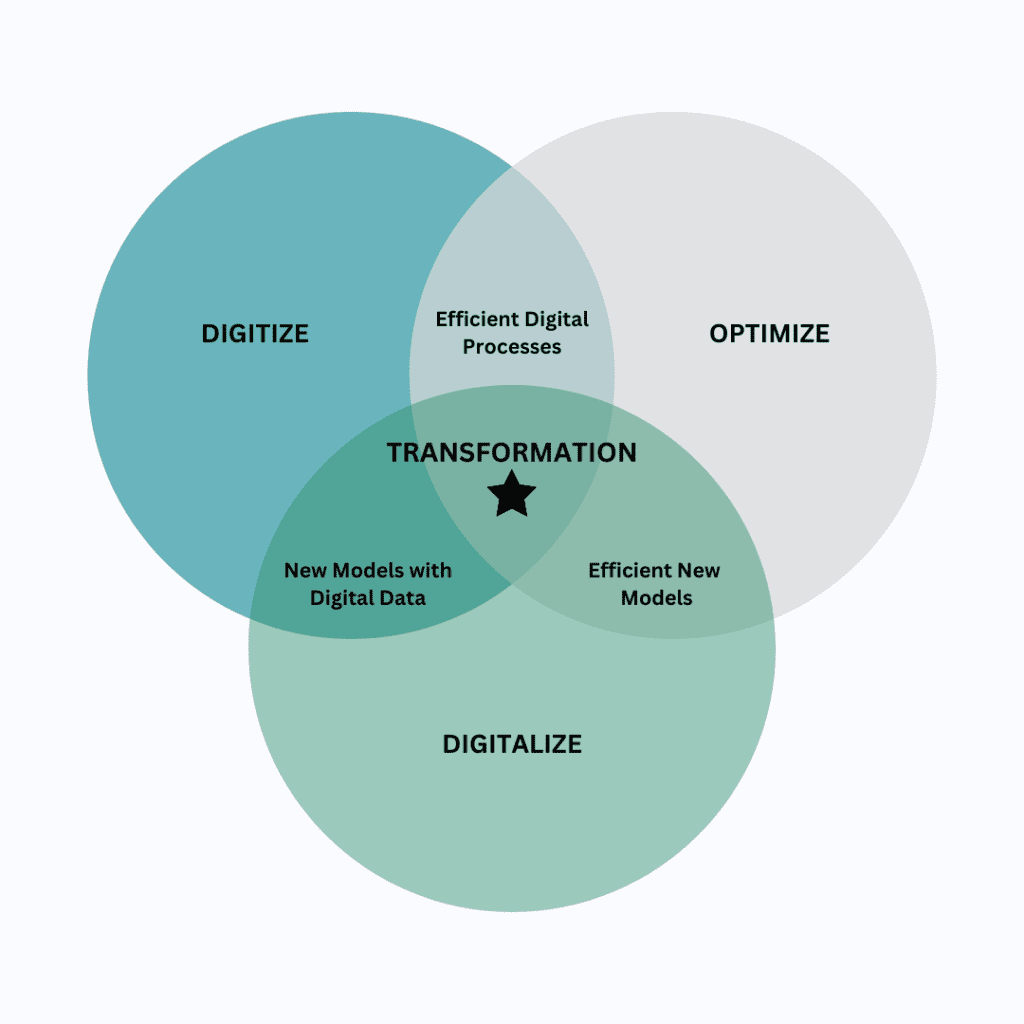In today’s rapidly evolving digital landscape, businesses are constantly faced with decisions about integrating technology to improve efficiency, enhance customer experiences, and create new value. As organizations assess their path forward in the digital age, understanding their current digital maturity is crucial to choosing the right strategy—digitizing, optimizing, or digitalizing. The accompanying diagram visually represents these strategic focuses and their intersections, guiding businesses on where they might fit within the digital transformation spectrum.
Understanding Digital Maturity
Digital maturity refers to the extent to which an organization has incorporated digital technology into its operations and culture. This maturity influences the current state of a company’s processes and its readiness to adopt new technologies and innovate business models. Companies at different levels of digital maturity will have different needs and capabilities when integrating digital strategies.
The Three Strategic Focuses
- Digitize: This is often the first step for businesses beginning their digital journey. Digitization involves converting analog information or processes into digital formats. For companies with legacy systems and a wealth of physical data, such as files, forms, or even physical customer interactions, starting with digitization is essential. This process does not inherently change how the business operates but serves as a crucial foundation for further digital strategies.
- Optimize: Optimization focuses on improving existing processes, often through the use of digital tools to enhance efficiency and effectiveness. For businesses that have already digitized their basic processes, optimization can mean streamlining operations, reducing costs, and improving service delivery through better data analytics and process management tools. This stage is critical for businesses that recognize inefficiencies within their current systems and are looking to improve upon them with the help of technology.
- Digitalize: Digitalization takes digitization a step further by using digital data and technologies to transform business models and create new revenue and value-producing opportunities. This strategy is suited for organizations that have already laid the digital groundwork through digitization and optimization. Digitalization involves a fundamental rethinking of how business is done, often leading to the development of new products and services or even entire new business segments.

Where to Start Based on Digital Maturity
Low Digital Maturity: Businesses that are just beginning to explore digital technologies should start with digitization. This foundational step is crucial for gathering digital data and moving away from analog systems that hinder scalability and flexibility. Starting here ensures that all further strategies are built on a digital base, enabling more sophisticated technologies and processes in the future.
Moderate Digital Maturity: Companies that have some level of digital processes in place but have not yet fully integrated technology across their operations should focus on optimization. At this stage, it’s important to refine and improve the efficiency of existing digital processes before attempting to innovate with new digital-first business models. Optimization can also serve to demonstrate the value of digital investments to stakeholders by showing immediate improvements in operational efficiency and cost savings.
High Digital Maturity: For organizations that have already digitized and optimized their processes, the next step is digitalization. This advanced stage allows companies to leverage their digital competency to innovate and transform their business models. Such companies are well-positioned to explore new markets, create innovative products or services, and redefine their industry standards.
Strategic Overlaps and Interactions
The diagram referenced earlier in this article illustrates the individual strategies and their overlaps, which are critical for businesses transitioning between stages of digital maturity. For example, a company moving from digitization to optimization might find itself in the overlap where it is beginning to refine digital processes initially converted from analog. Similarly, a company exploring the overlap between optimization and digitalization might streamline processes to support innovative business models.
The Importance of Utilization and Integration
A significant statistic to consider is that around 38% of enterprise software features are typically unused, leading to significant licensing waste, estimated at around $34 billion annually across the US and UK (BetterCloud). This highlights the importance of adopting technology and ensuring it is the right fit and fully utilized. Misalignments between technology adoption and business needs can inflate costs and create inefficiencies.
The Path Through Digitization
In conclusion, the path through digitization, optimization, and digitalization is not linear and involves overlapping strategies that depend heavily on an organization’s digital maturity. By understanding where they currently stand, companies can strategically navigate their digital transformation journey, ensuring that each step adds value and propels them toward a more innovative, efficient, and competitive future. The diagram used to illustrate these concepts serves as a visual roadmap, guiding businesses through the complexities of digital transformation in a structured and strategic way.




